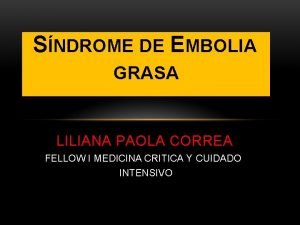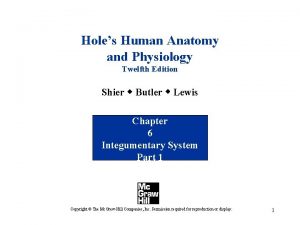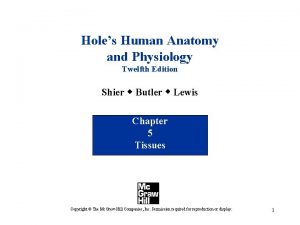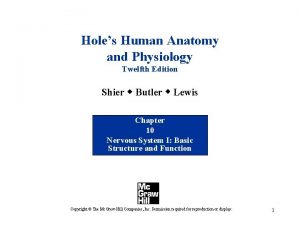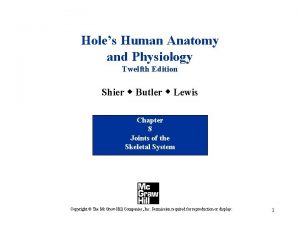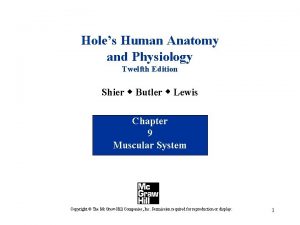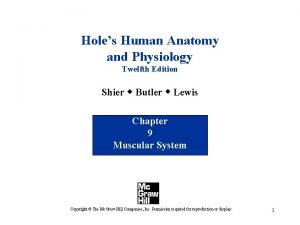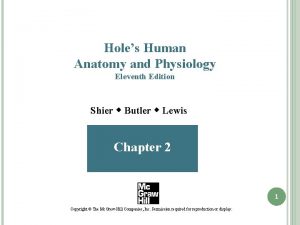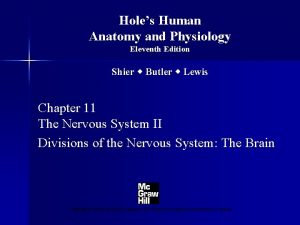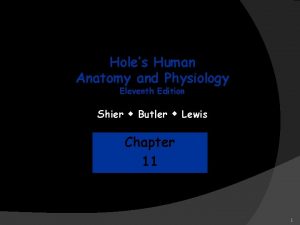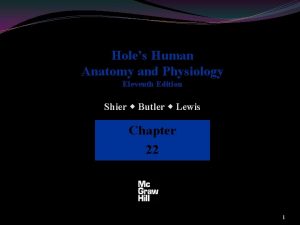Holes Human Anatomy and Physiology Twelfth Edition Shier

















- Slides: 17

Hole’s Human Anatomy and Physiology Twelfth Edition Shier w Butler w Lewis Chapter 3 Cells Copyright © The Mc. Graw-Hill Companies, Inc. Permission required for reproduction or display. 1

3. 1: Introduction • The basic unit of life is the cell. • There are 50 -100 trillion cells in the human body. • Cells interact and connect to form? • Cells that make up an adult human body have similarities and distinction. Cells consist of the same basic structures, yet vary in the number and distribution of their structure. • Differentiation is when cells specialize. 2 • As a result of differentiation, cells vary in size and shape

Differentiation is when cells specialize. As a result of differentiation, cells vary in size and shape due to their unique function. 3

• Cells continuously carries out activities essential for human life adapts to changing conditions. • Genes (pre-determined traits) controls a cells actions or responses. 4

3. 2: A Composite Cell Copyright © The Mc. Graw-Hill Companies, Inc. Permission required for reproduction or display. • Also called a ‘typical’ cell • Major parts include: • Cell Membrane-________ • Cytoplasm-________ • Cytosol-________ • Nucleus_________ Phospholipid bilayer Flagellum Nucleus Chromatin Nuclear envelope Nucleolus Ribosomes Cell membrane Basal body Microtubules Rough Endoplasmic reticulum Centrioles Mitochondrion Smooth Endoplasmic reticulum Microvilli Secretory vesicles Cilia Golgi apparatus Microtubules Lysosomes 5

Cell Membrane (aka Plasma Membrane) • Outer limit of the cell • Controls _________ • ___________ • Phospholipid bilayer • Water-soluble “heads” form surfaces (hydr______) • Water-insoluble “tails” form interior (hydro_____) • Permeable to lipid-soluble substances • Cholesterol stabilizes the membrane • Proteins: • Receptors • Pores, channels and carriers • Enzymes • CAMS________ • Self-markers 6

7

Cell Nucleus Copyright © The Mc. Graw-Hill Companies, Inc. Permission required for reproduction or display. • Control center of the cell • Nuclear envelope • Porous double membrane • Separates nucleoplasm from cytoplasm • Nucleolus • Dense collection of RNA and proteins • Site of ribosome production Nucleus Nuclear envelope Nucleolus • Chromatin • Fibers of DNA and proteins • Stores information for synthesis of proteins Chromatin Nuclear pores (a) 8

Cell Membrane Copyright © The Mc. Graw-Hill Companies, Inc. Permission required for reproduction or display. Extracellular side of membrane Fibrous protein Glycolipid Carbohydrate Glycoprotein “Heads” of phospholipid Double layer of Phospholipid molecules “Tails” of phospholipid Cell membrane (a) Cell membrane (b) a: © Biophoto Associates/Photo Researchers, Inc. Cholesterol Globular molecules protein Cytoplasmic side of membrane Hydrophobic fatty acid “tail” Hydrophilic Phosphate “head” 9

Cytoplasm • Cytosol = water • Organelles = solids Cytoplasm is really like a Jello fruit salad where the Jello is the cytosol and the fruits (oranges, grapes, bananas, maybe walnuts, etc. ) are the organelles. 10

Organelles Endoplasmic Reticulum (ER)Synthesis of ________ • Connected, membrane-bound sacs, canals, and vesicles • Transport system __________ • Rough ER Copyright © The Mc. Graw-Hill Companies, Inc. Permission required for reproduction or display. Membranes • Studded with ribosomes • Smooth ER • Lipid synthesis Ribosomes • Added to proteins arriving from rough ER Ribosomes (b) • Free floating or connected to ER • Provide structural support and enzyme activity to amino acids to form protein (c) 11

Organelles Golgi apparatus • Stack of flattened, membranous sacs • Modifies, packages and delivers proteins Vesicles • Membranous sacs • Store and transport substances within the cell Mitochondria • Membranous sacs with inner partitions • Generate energy Copyright © The Mc. Graw-Hill Companies, Inc. Permission required for reproduction or display. Inner membrane Cristae Outer membrane (a) (b) a: © Bill Longcore/Photo Researchers, Inc. 12

Organelles Lysosomes • Enzyme-containing sacs • Digest worn out cell parts or unwanted substances Centrosome • Two rod-like centrioles • Used to produce cilia and flagella • Distributes chromosomes during cell division Copyright © The Mc. Graw-Hill Companies, Inc. Permission required for reproduction or display. Peroxisomes • Enzyme-containing sacs • Break down organic molecules Centriole (cross-section) Centriole (longitudinal section) (a) (b) a: © Don W. Fawcett/Visuals Unlimited 13

Organelles Copyright © The Mc. Graw-Hill Companies, Inc. Permission required for reproduction or display. Cilia • Short hair-like projections • Propel substances on cell surface Flagellum • Long tail-like projection • Provides motility to sperm a: © Oliver Meckes/Photo Researchers, Inc. 14 © Colin Anderson/Brand X/CORBIS

Organelles Microfilaments and microtubules • Thin rods and tubules • Support cytoplasm • Allows for movement of organelles Copyright © The Mc. Graw-Hill Companies, Inc. Permission required for reproduction or display. Microtubules Inclusions • Temporary nutrients and pigments Microfilaments © M. Schliwa/Visuals Unlimited 15

What are organelles? VERY BASIC • Cell membrane – layer of fat & protein that protect the cell – the outside – the city limits • Nucleus – controls the functions - brain of cell , “boss” • Cytoplasm – jelly like substance that cushions & protects organelles 16

• Mitochondria – creates energy for cell • Lysosomes – digestion - waste disposal & recycling • Ribosomes - makes proteins needed to run the cell • Golgi apparatus (like the post office) is used for shipping things created by ER & ribosomes to rest of cell • Endoplasmic Reticulum (ER) is the road system within the cell – transports materials within the cell – Smooth & Rough 17
 Holes essential of human anatomy and physiology
Holes essential of human anatomy and physiology 3 layers of muscle
3 layers of muscle Human anatomy and physiology 10th edition
Human anatomy and physiology 10th edition Holes anatomy and physiology chapter 1
Holes anatomy and physiology chapter 1 Human anatomy & physiology edition 9
Human anatomy & physiology edition 9 Chapter 1 introduction to human anatomy and physiology
Chapter 1 introduction to human anatomy and physiology Chapter 1 introduction to human anatomy and physiology
Chapter 1 introduction to human anatomy and physiology Chapter 2 human reproductive anatomy and physiology
Chapter 2 human reproductive anatomy and physiology Api testing
Api testing Escala de shier
Escala de shier Shy loud
Shy loud Management twelfth edition
Management twelfth edition Human anatomy fifth edition
Human anatomy fifth edition Human anatomy fifth edition
Human anatomy fifth edition Physiology of sport and exercise 5th edition
Physiology of sport and exercise 5th edition The upper respiratory tract
The upper respiratory tract Tattoo anatomy and physiology
Tattoo anatomy and physiology Science olympiad anatomy and physiology
Science olympiad anatomy and physiology









